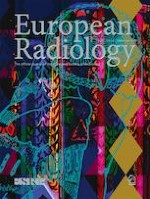Erschienen in:

09.06.2022 | Urogenital
Evaluation of the T2-weighted (T2W) adrenal MRI calculator to differentiate adrenal pheochromocytoma from lipid-poor adrenal adenoma
verfasst von:
Rosalind Gerson, Wendy Tu, Jorge Abreu-Gomez, Amar Udare, Rachel McPhedran, Tim Ramsay, Nicola Schieda
Erschienen in:
European Radiology
|
Ausgabe 12/2022
Einloggen, um Zugang zu erhalten
Abstract
Objectives
To evaluate the T2-weighted (T2W) MRI calculator to differentiate adrenal pheochromocytoma from lipid-poor adrenal adenoma.
Methods
Twenty-nine consecutive pheochromocytomas resected between 2010 and 2019 were compared to 23 consecutive lipid-poor adrenal adenomas. Three blinded radiologists (R1, R2, R3) subjectively evaluated T2W signal intensity and heterogeneity and extracted T2W signal intensity ratio (SIR) and entropy. These values were imputed into a quantitative and qualitative T2W adrenal MRI calculator (logistic regression model encompassing T2W SIR + entropy and subjective SI [relative to renal cortex] and heterogeneity) using a predefined threshold to differentiate metastases from adenoma and accuracy derived by a 2 × 2 table analysis.
Results
Subjectively, pheochromocytomas were brighter (p < 0.001) and more heterogeneous (p < 0.001) for all three radiologists. Inter-observer agreement was fair-to-moderate for T2W signal intensity (K = 0.37–0.46) and fair for heterogeneity (K = 0.24–0.32). Pheochromocytoma had higher T2W-SI-ratio (p < 0.001) and entropy (p < 0.001) for all three readers.
The quantitative calculator differentiated pheochromocytoma from adenoma with high sensitivity, specificity, and accuracy (100% [95% confidence intervals 88–100%], 87% [66–97%], and 94% [86–100%] R1; 93% [77–99%], 96% [78–100%], and 94% [88–100%] R2; 97% [82–100%], 96% [78–100%], and 96% [91–100% R3]). The qualitative calculator was specific with lower sensitivity and overall accuracy (48% [29–68%], 100% [85–100%], and 74% [65–83%] R1; 45% [26–64%], 100% [85–100%], and 72% [63–82%] R2; 59% [39–77%], 100% [85–100%], and 79% [70–88% R3]).
Conclusions
T2W signal intensity and heterogeneity differ, subjectively and quantitatively, in pheochromocytoma compared to adenoma. Use of a quantitative T2W adrenal calculator which combines T2W signal intensity ratio and entropy was highly accurate to diagnose pheochromocytoma outperforming subjective analysis.
Key Points
•
Pheochromocytomas have higher T2-weighted signal intensity and are more heterogeneous compared to lipid-poor adrenal adenomas evaluated subjectively and quantitatively.
•
The quantitative T2-weighted adrenal MRI calculator, a logistic regression model combining T2-weighted signal intensity ratio and entropy, is highly accurate for diagnosis of pheochromocytoma.
•
The qualitative T2-weighed adrenal MRI calculator had high specificity but lower sensitivity and overall accuracy compared to quantitative assessment and agreement was only fair-to-moderate.